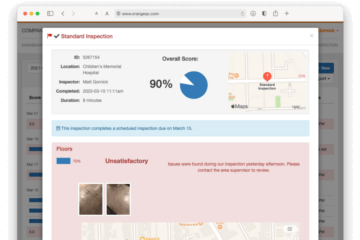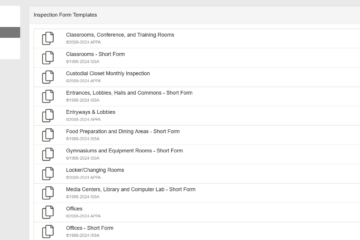One inspector goes through an office and rates the carpets as a 3. Another comes through and gives them a 4. That might not seem like a big problem — but it is. It means you can’t trust that your data is telling the truth about your quality.
Quality control data is only as good as your inspections, and consistent data is key to seeing the real trends going on in your facilities. The data you collect from inspections is integral to your business, so it’s important to have confidence in it. With better data, you can make more informed decisions for your team and your business.
We’re going to break down why you need a consistent process, how to establish a standard of clean, three ways to “inspect the inspector,” and a few first steps you can take towards standardizing your quality control process right now.
Why consistency is key
Having consistency between your inspectors formalizes your process, making it repeatable and scaleable. Consistency ensures that even with employee turnover and new team members, your data is reliable. It gives you confidence that the trends you see in your scores are due to actual changes in cleaning quality, not one of your inspectors having a bad day.
Consistency allows you to prioritize your resources and spend your time on areas that are most critical. If an inspector is incorrectly stating that an area needs work when it doesn’t, you will be wasting time and resources in addressing something that may already be up to standards. Plus, it’s frustrating for cleaning staff to get mixed messages on the right level of clean.
So how do you get inspectors on the same page?
Start with a standard of clean
The first step: Establish a standard of clean for your janitorial inspection checklist. Whether you’re choosing a new rating system or better defining your existing one, you’ll need clarity around what quality levels deserve what score.
Don’t have a rating system yet? Check out our article on APPA’s Five Levels of Clean (for educational organizations) and ISSA’s Cleaning Industry Management Standard (CIMS). There is no point in reinventing the wheel, and these are great resources to help everyone get on the same page.
Of course, many of you have already established and refined your standard of clean. But just because you have the standard doesn’t mean everyone’s sticking to it. For that, you’ll need to work closely with your inspectors.
Three methods for inspecting the inspector
Many of our high-performing teams make it a priority to inspect their inspectors. It’s one of the best ways to create consistency with your team. Here are a few different ways you can do it:
- Joint inspection. The first method, which is the best way to get started, is similar to the Public Relations (PR) report, or a Joint Management Inspection. A key person, such as the head of operations or the lead quality control coordinator, conducts a joint inspection with one of the inspectors. The inspector will take the lead and talk through their ratings and process. They’ll explain why they are giving certain ratings and when they are taking photos or notes. The quality control inspector will highlight areas that diverge from the standard, giving the opportunity to set your baseline.
This type of inspection is quick and allows for training, feedback, and guidance. It should be a key part of training new inspectors and done regularly with your staff. - Inspector vs. Inspector. Another option is to have two different inspectors do the inspection in the same space, one soon after another, separately. After the inspections are done, look for variants. Address where the ratings are different. This will reveal which of your inspectors might need more training, as well as where you might been to be clearer on your rating system.
- Leaderboard Metrics. Take a look at the leaderboard or aggregate metrics to get insights so you know where to dig deeper. A tool like OrangeQC can help with this, or you can run an analysis with Excel. Take a look at which team members are doing the most inspections, who is tracking more deficient inspections, and when particular users are diverging from the pattern of the group.
There may be one team member who consistently gives lower ratings than everyone else. Perhaps they’re correct or maybe they’re deviating from the standard and not providing you with accurate data. Either way, it’s important to analyze the data so you have the right picture.
We often get asked if it’s better to have certain inspectors focus on one subject matter or rotate through sites. The short answer is that it depends on the team, their environment, and their areas of responsibility.
Our suggestion is to have your inspectors stay within their current bounds of areas of responsibility. If they’re primarily dealing with healthcare clients and facilities, then keep them in their area of expertise.
On the other hand, if you’re a building service contractor (BSC) and working with a wide variety of client types, then you’ll need to have those team members rotate through. Since they’re responsible for all different types of clients and facility types, they’ll need experience and an objective look at all of your facilities.
How to get started on refining your scoring procedures
First, as we said above, you need to define your quality control process. If you haven’t done that yet, read our article about how to set quality control goals for your team.
Then, start with our recommendation to conduct a joint inspection. Use that as a way of conducting training, feedback and results all in one step. With a short feedback loop, you can easily discover how the inspector diverged from what the lead coordinator outlined, establishing where there are inaccuracies so your team can make that correction moving forward.
When working toward consistency, keep an eye on both quantitative levels of clean as well as your business process. While these are different, both are important:
- Quantitative levels of clean. This means consistency in score, scorable attributes, or ratings. For example, are the trash cans an APPA Level 2 or 3, pass or fail, 85% or 75%?
- Business process. If deficiencies are tracked, institute objectives, such as team members should take one to five photos during each inspection. Or maybe you want them to leave comments and notes or details about their proposed corrective action.
While identifying inaccuracies and inconsistencies is an important step to take, it is just as important to create goals for your team so everyone is on the same page moving forward.
Whether you decide to go with an innovative tool like OrangeQC or create your own spreadsheet, make sure there is a clear process for creating consistency between your inspectors. It’s the best way to get reliable data you can trust to reveal quality control trends at your sites.



